| Woodrow Wilson Bridge Project Photos - September 2005 |
The following 85 photos show various aerial views of the I-95/I-495 Woodrow Wilson Bridge (WWB) Project construction, including the new Potomac River Bridge construction, the Virginia U.S. Route 1 Interchange construction, the Washington Street Urban Deck construction, and the Maryland Interstate 295 Interchange construction.
These photos were taken on September 27, 2005, by the Virginia Department of Transportation, and are posted here with their permission. Roads to the Future utilized PhotoDeluxe Business Edition to sharpen and brighten and to align and crop all of the photos. Click on the photo to get a large version of the photo. In later versions of Netscape and Internet Explorer, you probably will need to use Full Screen mode (the F11 key can be utilized to swap back and forth between Full Screen and Regular) to see the full size of the large photo without browser-induced image shrinkage. The large photos have sizes ranging from 98 to 485 kilobytes, with most of them being under 188 kilobytes. With a broadband or network Internet connection each photo will download within seconds, but with a dial-up Internet connection it will be somewhat slower.
 |
U.S. Route 1 Interchange construction, looking east across Hunting Creek (also known as Cameron Run), and the 8-lane I-95/I-495 Capital Beltway, with Alexandria on the north side of the Beltway, and the Potomac River and the existing 6-lane and under construction 12-lane Woodrow Wilson Bridges are visible in the distance. The long new bridge on the near side of the Beltway, is part of the just-completed US Route 1 Interchange Advanced Bridge contract, and the bridge will carry the Beltway Outer Loop local roadway. The cleared area on both sides of the Beltway is for the widened highway. |
 |
U.S. Route 1 Interchange construction, looking east across Hunting Creek, and the I-95/I-495 Capital Beltway, with Alexandria on the north side of the Beltway. This is a closer view of the right center portion of the previous photo. US-1 runs generally left to right in this photo. The bridges in the lower left corner, the new elevated ramps, and the new elevated outer ramp on the far side of US-1, are parts of the US Route 1 Interchange Advanced Bridge contract, which is complete. |
 |
U.S. Route 1 Interchange construction, looking east across Hunting Creek, and the I-95/I-495 Capital Beltway, with Alexandria on the north side of the Beltway. The Woodrow Wilson Bridge and Potomac River is in the distance. The US Route 1 Interchange (Major Portion) contract is in its early stages, and is 20% complete as of the October 2005 release of this article. |
 |
U.S. Route 1 Interchange construction, looking east across Hunting Creek, and the I-95/I-495 Capital Beltway, with Alexandria on the north side of the Beltway. The Woodrow Wilson Bridge and Potomac River is in the distance. |
 |
U.S. Route 1 Interchange construction, looking east across Hunting Creek, and the I-95/I-495 Capital Beltway, with Alexandria on the north side of the Beltway. This photo was taken from over US-1, and the new ramps can be seen on either side of US-1. |
 |
U.S. Route 1 Interchange construction, looking north across Hunting Creek, and the I-95/I-495 Capital Beltway, with Alexandria on the north side of the Beltway. This photo was taken from over US-1, and the new ramps can be seen on either side of US-1. The two new southerly ramps connecting the Beltway to US-1 (Outer Loop to US-1 southbound, and US-1 northbound to Outer Loop), were opened to traffic in August and September 2005, respectively. |
 |
U.S. Route 1 Interchange construction, looking north across Hunting Creek, and the I-95/I-495 Capital Beltway, with Alexandria on the north side of the Beltway. The new ramp from US-1 northbound to the Outer Loop of the Beltway, can be seen in the center of the photo, and this bridged ramp has a separate pedestrian/bicycle trail on the east side of the bridge, and the trail carries pedestrian/bicycle traffic between US-1 south of Alexandria and Washington Street and the pedestrian/bicycle trail which will cross the Potomac River on the new Woodrow Wilson Bridge to pedestrian/bicycle trails in Maryland. |
 |
U.S. Route 1 Interchange construction, looking north across Hunting Creek, and the I-95/I-495 Capital Beltway, with Alexandria on the north side of the Beltway. |
 |
U.S. Route 1 Interchange construction, looking north across Hunting Creek, and the I-95/I-495 Capital Beltway, with Alexandria on the north side of the Beltway. |
 |
Virginia approaches construction to the Potomac River Bridge, looking west. Construction in the foreground is the Potomac River Bridge Virginia Approach Spans contract. |
 |
Virginia approaches construction to the Potomac River Bridge, looking west. Construction in the foreground is the Potomac River Bridge Virginia Approach Spans contract, and the new under construction 6-lane Outer Loop WWB is visible, with the existing 6-lane WWB to the right. The new Virginia abutment for the Potomac River Bridge is visible in the center of the photo, and the land approach construction is visible above that, with the Hunting Towers apartment complex to the left of that, and the Washington Street Deck construction is visible, with the existing U.S. Route 1 Interchange visible in the distance. |
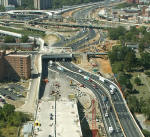 |
Looking west along the Beltway, showing construction of the Washington Street Urban Deck in Alexandria VA, and the U.S. Route 1 Interchange in the distance. The new highway's retaining walls close to the buildings are complete, and the Washington Street Deck has been completed over the future local and express Beltway Outer Loop roadways. The Beltway detour roadway has been completed and traffic was shifted to it, the Outer Loop after a weekend-long tie-in construction period July 15-18, and the Inner Loop after a weekend-long tie-in construction period August 12-15. During each weekend, traffic in that direction was narrowed down to one lane on that directional roadway while thousands of tons of asphalt was placed in order to connect the detour roadway to the Beltway mainline. The west ends of the existing and under construction Woodrow Wilson Bridges are visible in the lower part of the photo. Some of the Hunting Towers Apartments are visible in the left center of the photo. The US-1 interchange is visible in the distance. The telephoto effect exaggerates the curvature of the highway, as the detour is easily drivable at 50 mph. This is what it looked like just before the tie-in construction started -- WWB-Aerial-Jun1705-1. With the Beltway traffic shifted out of the way, now construction can proceed on the northern half of the Washington Street Deck, to complete the whole deck. This image is a zoom-in excerpt from the previous image. |
 |
U.S. Route 1 Interchange construction, looking south across the I-95/I-495 Capital Beltway and Hunting Creek. The new ramp bridges are part of the US Route 1 Interchange Advanced Bridge contract. |
 |
U.S. Route 1 Interchange construction, looking south across the I-95/I-495 Capital Beltway and Hunting Creek. The new ramp bridges are part of the US Route 1 Interchange Advanced Bridge contract. |
 |
U.S. Route 1 Interchange construction, looking east along the 8-lane I-95/I-495 Capital Beltway, with Hunting Creek on the right, with Alexandria on the north side of the Beltway, and the Potomac River and existing 6-lane and under construction Woodrow Wilson Bridges visible in the distance. The long new bridge on the right side of the Beltway, is part of the US Route 1 Interchange Advanced Bridge contract, and the bridge will carry the Beltway Outer Loop local roadway. |
 |
U.S. Route 1 Interchange construction, looking east across Hunting Creek (also known as Cameron Run), and the 8-lane I-95/I-495 Capital Beltway, with Alexandria on the north side of the Beltway, and the Potomac River and the existing 6-lane and under construction 12-lane Woodrow Wilson Bridges are visible in the distance. The cleared area on both sides of the Beltway is for the widened highway. |
 |
Looking eastward along the Beltway, from above the US-1 interchange in Virginia, and the Woodrow Wilson Bridge, Potomac River and Maryland are visible in the distance. Notice the recently-opened Beltway detour roadway, and the existing WWB to the left and the under construction WWB to the right. This image is a zoom-in excerpt from the previous image. |
 |
U.S. Route 1 Interchange construction, looking east across Hunting Creek, and the 8-lane I-95/I-495 Capital Beltway, with Alexandria on the north side of the Beltway, and the Potomac River and the existing and under construction Woodrow Wilson Bridges are visible in the distance. The long new bridge on the near side of the Beltway, is part of the US Route 1 Interchange Advanced Bridge contract, and the bridge will carry the Beltway Outer Loop local roadway, and this WWB Project contract has just been completed, and the two new southerly ramps connecting the Beltway to US-1 (Outer Loop to US-1 southbound, and US-1 northbound to Outer Loop), were opened to traffic in August and September 2005, respectively. These are the new outer elevated ramps visible to the right of the photo. |
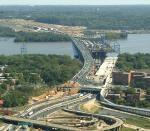 |
Looking eastward along the Beltway, from above the US-1 interchange in Virginia, and the Woodrow Wilson Bridge, Potomac River and Maryland are visible in the distance. Notice the recently-opened Beltway detour roadway, and the existing WWB to the left and the under construction WWB to the right. This image is a zoom-in excerpt from the previous image. |
 |
U.S. Route 1 Interchange construction, looking east across Hunting Creek, and the 8-lane I-95/I-495 Capital Beltway, with Alexandria on the north side of the Beltway, and the Potomac River and the existing and under construction Woodrow Wilson Bridges are visible in the distance. |
 |
U.S. Route 1 Interchange construction, looking north across Hunting Creek, and the I-95/I-495 Capital Beltway, with Alexandria on the north side of the Beltway. This photo was taken from over US-1. |
 |
U.S. Route 1 Interchange construction, looking north across Hunting Creek, and the I-95/I-495 Capital Beltway, with Alexandria on the north side of the Beltway |
 |
U.S. Route 1 Interchange construction, looking north across Hunting Creek, and the I-95/I-495 Capital Beltway, with Alexandria on the north side of the Beltway. The new ramps can be seen on either side of US-1. The new ramp from US-1 northbound to the Outer Loop of the Beltway, can be seen in the center of the photo, and this bridged ramp has a separate pedestrian/bicycle trail on the right side of the bridge, and the trail will carry pedestrian/bicycle traffic between US-1 south of Alexandria and Washington Street and the pedestrian/bicycle trail which will cross the Potomac River on the new Woodrow Wilson Bridge to pedestrian/bicycle trails in Maryland. |
 |
Mount Vernon Memorial Highway runs from the bottom of the photo, upward past the apartment complex where the Mount Vernon Memorial Highway becomes Washington Street, and Washington Street crosses the Beltway and goes into Old Town Alexandria. The Beltway runs left-right across the center of the photo. |
 |
Potomac River Bridge under construction, looking north. Construction in the photo is the Potomac River Bridge Virginia Approach Spans contract. The new Virginia abutment for the Potomac River Bridge is visible in the left of the photo. The existing Woodrow Wilson Bridge and Old Town Alexandria are visible in the upper part of the photo. |
 |
Potomac River Bridge construction, looking north,
view of the Virginia Approach Spans construction. Most of the WWB in Virginia is over land, as the main shipping channel is about 500 feet from the Virginia shoreline. |
 |
Potomac River Bridge construction, looking west, view of the Virginia Approach Spans construction. The new 6-lane Outer Loop bridge is to the left, and the piers, girders and roadway deck have been constructed on this section. The existing 6-lane WWB is to the right. The Virginia abutments for the Potomac River Bridges are visible in the top of the photo. |
 |
Potomac River Bridge construction, looking north, view of the Virginia Approach Spans construction. |
 |
Potomac River Bridge construction, looking north, view of the Virginia Approach Spans construction. The existing Woodrow Wilson Bridge and Old Town Alexandria and the Potomac River are visible in the upper part of the photo. Jones Point is visible in the photo. The Potomac River and downtown Washington, D.C. is in the distance. |
 |
Potomac River Bridge construction, looking north, view of the Virginia Approach Spans construction. The bridges cross Jones Point. |
 |
Potomac River Bridge construction, view of the Bascule Span construction, which is being built under the Potomac River Bridge Bascule Spans contract. The existing WWB is behind the bridge under construction. |
 |
Potomac River Bridge construction, view of the Bascule Span construction. The existing WWB is behind the bridge under construction. |
 |
Potomac River Bridge construction, closer view of the Bascule Span construction. Looking north, downtown Washington, D.C. is in the distance, and Old Town Alexandria is on the left. Part of the bascule spans have been installed. |
 |
Potomac
River Bridge construction, view of the Bascule Span construction.
The existing 6-lane Woodrow Wilson Bridge is visible on the opposite side of the new bridge construction. |
 |
Potomac River Bridge construction, looking north, view of the Maryland Approach Spans construction, which is being built under the Potomac River Bridge Maryland Approach Spans contract. Delta pier construction is underway on the bridge foundation in the center of the photo. The foundations were built in the Potomac River Bridge Foundations contract. |
 |
Potomac River Bridge construction, looking north, view of the Maryland Approach Spans construction. The delta piers on the approach spans are being constructed via the precast segmental method, whereby reinforced concrete segments are fabricated in a fabrication yard, and assembled on the pier foundations and post-tensioned with steel cables that pass through channels in the piers. |
 |
Potomac River Bridge construction, looking north, view of the Maryland Approach Spans construction. |
 |
Potomac River Bridge construction, looking north, view of the Maryland Approach Spans construction. |
 |
Potomac River Bridge construction, looking north, view of the Maryland Approach Spans construction. |
 |
Potomac River Bridge construction, looking north, view of the Maryland Approach Spans construction. |
 |
Potomac River Bridge construction, looking north, view of the Maryland Approach Spans construction. |
 |
Potomac River Bridge construction, looking north, view of the Maryland Approach Spans construction. Delta pier construction is underway on the bridge foundations. The under construction Maryland abutment for the new Potomac River Bridge is visible in the right of the photo. |
 |
Potomac River Bridge construction, looking north, view of the Maryland Approach Spans construction. The under construction Maryland abutment for the new Potomac River Bridge is visible in the left of the photo, and the Rosalie Island land approach construction is to the right. |
 |
Interstate 295 Interchange construction, looking east, the Potomac River Bridge is just off of the left edge of the photo, and the I-95/I-495 Beltway sweeps into the distance, with I-295 to the right as it extends to MD-210 Indian Head Highway in the distance. |
 |
Interstate 295 Interchange construction, looking east, the Potomac River Bridge is just off of the left edge of the photo, and the I-95/I-495 Beltway sweeps into the distance, with I-295 to the right as it extends to MD-210 Indian Head Highway in the distance. |
 |
Interstate
295 Interchange construction, looking northeast.
High capacity roadways and ramps are being constructed
to make this a 4-way interchange, with the southerly extension heading into
the National Harbor development which began construction in 2004.
Website for National Harbor. |
 |
Interstate 295 Interchange construction, looking northeast. |
 |
Interstate 295 Interchange construction, looking northeast. |
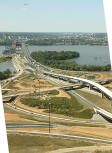 |
Interstate 295 Interchange construction, looking
west along the I-95/I-495 Beltway. The Woodrow Wilson Bridge across the Potomac
River is in the upper left part of the photo, with the existing WWB to the
right and the under construction new WWB to the left, and Virginia is on the opposite
side of the Potomac River. An airliner on final landing approach to Washington National Airport which is 4 miles to the north, is visible near the top of the photo on the left side. |
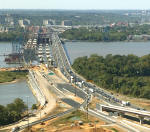 |
Interstate 295 Interchange and Woodrow Wilson Bridge construction, looking west, with the existing WWB to the right and the under construction new WWB to the left, and Virginia is on the opposite side of the Potomac River. This image is a zoom-in excerpt from the previous image. |
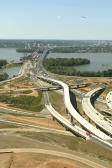 |
Interstate 295 Interchange construction, looking west along the I-95/I-495 Beltway. The Woodrow Wilson Bridge across the Potomac River is in the upper left part of the photo, with the existing WWB to the right and the under construction new WWB to the left, and Virginia is on the opposite side of the Potomac River. |
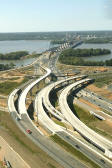 |
Interstate 295 Interchange construction, looking west along the I-95/I-495 Beltway. The Woodrow Wilson Bridge across the Potomac River is in the upper center part of the photo. I-295 curves over the Beltway on the two new bridges to the right, and I-295 terminates at MD-210 Indian Head Highway about a mile to the east. The two new bridges to the left are ramps connecting the Beltway Outer Loop to I-295. |
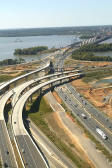 |
Interstate 295 Interchange construction, looking west along the I-95/I-495 Beltway. |
 |
Interstate 295 Interchange construction, looking west along the I-95/I-495 Beltway. The Woodrow Wilson Bridge across the Potomac River is in the upper right part of the photo, with the existing WWB to the right and the under construction new WWB to the left, and Virginia is on the opposite side of the Potomac River. |
 |
Woodrow Wilson Bridge construction, looking west. This image
is a zoom-in excerpt from the previous image. See very large image (690 kilobytes). |
 |
Interstate 295 Interchange and Woodrow Wilson Bridge construction, looking southwest. |
 |
Interstate 295 Interchange construction, looking south. |
 |
Interstate 295 Interchange construction, looking
south. High capacity roadways and ramps are being constructed to make this
a 4-way interchange, with the southerly extension heading into the National
Harbor development which began construction in 2004, and whose grading and
site preparation can be seen in the distance. Website for
National Harbor.
I-295 curves over the Beltway on the two new bridges to the left, and I-295
terminates at MD-210 Indian Head Highway about a mile to the east.
|
 |
Interstate 295 Interchange construction, looking southeast. I-295 curves over the Beltway on the two new bridges to the left. |
 |
Interstate 295 Interchange construction, looking southeast. I-295 curves over the Beltway on the two new bridges to the left. |
 |
WWB Project construction on Rosalie Island in Maryland. The east end and east abutment of the under construction Potomac River Bridge is visible in the lower right of the photo. The piers for an under construction overpass are visible in the upper left of the photo, and that overpass will carry a hiking and bicycle trail. |
 |
WWB Project construction on Rosalie Island in Maryland, looking east along the I-95/I-495 Beltway, from over the Potomac River toward Maryland. The east end and east abutment of the under construction Potomac River Bridge is visible in the center of the photo. The existing WWB is visible to the left. |
 |
Interstate 295 Interchange construction, looking northeast, the I-95/I-495 Beltway sweeps into the distance. |
 |
Interstate 295 Interchange construction, looking north. High capacity roadways and ramps are being constructed to make this a 4-way interchange, with the southerly extension heading into the National Harbor development which began construction in 2004. Website for National Harbor. |
 |
Interstate 295 Interchange construction, looking nouth, the south section of the interchange that heads into the property of the National Harbor development. The center and lower part of the photo shows the fabrication yard for the pre-casting of the segments that are being utilized for the piers on the Potomac River Bridge Maryland Approach Spans construction. This fabrication yard is visible in the previous photo, and the previous photo shows the Potomac River docks for barges that transport materials to the project. |
 |
Interstate 295 Interchange construction, looking northwest. The I-95/I-495 Beltway runs left-right, and I-295 is seen as it sweeps upward, to the center of Washington, D.C. |
 |
Interstate 295 Interchange and Woodrow Wilson Bridge construction, looking west. |
|
|
Woodrow Wilson Bridge construction, looking west. This image is a zoom-in
excerpt from the previous image. Old Town Alexandria is on the other side
of the river. See very large image (750 kilobytes). |
 |
Interstate 295 Interchange construction, looking northwest. The I-95/I-495 Beltway runs left-right, the Woodrow Wilson Bridge is in the upper left corner, and Virginia is on the opposite side of the Potomac River. |
 |
Interstate 295 Interchange construction, looking west. The I-95/I-495 Beltway runs lower-right to center, the Woodrow Wilson Bridge is in the upper part of the photo, and Virginia is on the opposite side of the Potomac River. |
 |
Interstate 295 Interchange construction, looking west. The I-95/I-495 Beltway runs lower-right to center, the Woodrow Wilson Bridge is in the upper part of the photo, and Virginia is on the opposite side of the Potomac River. I-295 curves over the Beltway on the two new bridges to the right, and I-295 terminates at MD-210 Indian Head Highway about a mile to the east. The two new bridges to the left are ramps connecting the Beltway Outer Loop to I-295. |
 |
Interstate 295 Interchange construction, looking west. The I-95/I-495 Beltway runs lower-right to center, the Woodrow Wilson Bridge is in the upper part of the photo, and Virginia is on the opposite side of the Potomac River. |
 |
Interstate 295 Interchange construction, looking west. The I-95/I-495 Beltway runs lower-right to center, the Woodrow Wilson Bridge is in the upper part of the photo, and Virginia is on the opposite side of the Potomac River. |
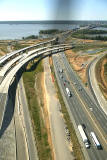 |
Interstate 295 Interchange construction,
looking west. The I-95/I-495 Beltway runs up-down, the Woodrow Wilson
Bridge is in the upper part of the photo, and Virginia is on the opposite
side of the Potomac River. The blur in the top of the photo may have come from a support in the windshield of the helicopter. |
 |
Potomac River Bridge construction, looking south, view of
the Maryland Approach Spans construction, near the Maryland shoreline. The delta piers on the approach spans are being constructed via the precast segmental method, whereby reinforced concrete segments are fabricated in a fabrication yard, and assembled on the pier foundations and post-tensioned with steel cables that pass through channels in the piers. The arches are held in place by temporary steel cables until the reinforced concrete cross-member links the two arches. The bridge's steel beams and roadway deck will be constructed across the top of the piers. |
 |
Potomac
River Bridge construction, looking south, view of the Maryland Approach
Spans construction, near the Maryland shoreline. The existing 6-lane Woodrow Wilson Bridge is visible on the near side of the new bridge construction. |
 |
Potomac River Bridge construction, looking south, view of the Maryland Approach Spans construction, which is being built under the Potomac River Bridge Maryland Approach Spans contract. |
 |
Potomac River Bridge construction, looking
south, view of the Maryland Approach Spans construction.
|
 |
Potomac River Bridge construction, looking south, view of the Maryland Approach Spans construction. |
 |
Construction in the center of the photo is the Potomac River Bridge Virginia Approach Spans contract. The existing Woodrow Wilson Bridge is on the near side of the construction. Jones Point is visible in the upper center of the photo. |
 |
Potomac River Bridge Virginia Approach Spans construction. The existing Woodrow Wilson Bridge is on the near side if the construction. Jones Point is visible in the upper left of the photo. The Bascule Span construction is visible in the left of the photo, which is being built under the Potomac River Bridge Bascule Spans contract. |
 |
Virginia approaches construction to the Potomac River Bridge, looking south. The new 12-lane twin-span bridge is being built just to the south of the existing 6-lane Woodrow Wilson Bridge. The Hunting Towers apartment complex is in the upper right of the photo. The Virginia abutment (terminal structure) of the bridges is visible in the left of the photo. |
 |
U.S. Route 1 Interchange construction, looking south along U.S. Route 1 which goes into the distance, with the Beltway running left-right. The original U.S. Route 1 Interchange has a considerable amount of bridgework across areas of water and low-lying land, with a long bridge on U.S. 1 and bridges on four of the ramps. The interchange seen here is in essentially the same format as when it opened to traffic in 1961, with a modified cloverleaf design with a semi-directional ramp connecting southbound U.S. 1 to northbound I-95/I-495, and with a collector-distributor (C-D) roadway intercepting the two loop ramps on southbound I-95/I-495. |
 |
U.S. Route 1 Interchange construction, looking south across the I-95/I-495 Capital Beltway and Hunting Creek. The new ramp bridges are part of the US Route 1 Interchange Advanced Bridge contract. |
Lead article - Woodrow Wilson Bridge Project Photos
This article was released on October 1, 2005, with the 7 photos, 11x, 15x, 16, 16x, 29, 30 and "F". The 38 photos between 1 and 41 inclusive were added on October 15, 2005, and the 30 photos between 42 and 67 inclusive were added on November 1, 2005, and the 10 photos between 68 and 77 inclusive were added on November 16, 2005 (some of the numbered photos have several versions, adding photos to the basic numbering scheme of 01 to 77).
Copyright © 2005 by Scott Kozel. All rights reserved. Reproduction, reuse, or distribution without permission is prohibited.
By Scott M. Kozel, Capital Beltway dot com, Roads to the Future
(Created 10-1-2005, updated 11-16-2005, moved to capital-beltway.com on 3-18-2007)
